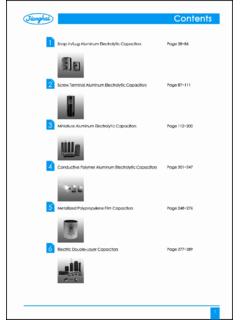Transcription of Electrolytic Capacitor Lifetime Estimation
1 Electrolytic Capacitor Lifetime Estimation Dr. Arne Albertsen, JIANGHAI EUROPE GmbH Introduction Aluminum Electrolytic capacitors ( alu-elcaps , elcaps ) are essential for the function of many electronic devices. Ever increasing demand for enhanced efficiency, the expanding utilization of renewable energy and the continuous growth of electronic content in automotive applications have driven the usage of these components. In many applications , the Lifetime of electronic devices is directly linked to the Lifetime of the elcaps inside [9].
2 To ensure reliable operation of electronic devices for a defined period, a thorough knowledge of the vital properties of elcaps is mandatory. The present article outlines the construction of elcaps and explains related terms like ESR, ripple current, self-heating, chemical stability, and Lifetime . Two Estimation tools for obtaining elcap Lifetime approximations in an application are introduced and illustrated by an example. Construction of Elcaps Aluminum Electrolytic capacitors combine voltage proof capabilities starting at a few Volts up to approx.
3 700V and a wide capacitance range from 1 F extending beyond 1 F while being very compact in size. A highly roughened anode foil is covered by a thin dielectric layer and the complete surface area is contacted by an exact-fitting cathode, the electrolyte liquid (Fig. 1). Fig. 1: Internal construction of an Elcap The liquid electrolyte is making the construction of Electrolytic capacitors special and its existence yields some technical consequences. The flow of electrical current through the electrolyte is mediated by the movement of ions.
4 An increase of the electrolyte temperature thus decreases its viscosity and in turn lowers the electrical resistance (ESR). The boiling point of the electrolyte determines the upper category temperature and limits the maximum permissible self-heating caused by the ripple current in conjunction with the ambient temperature. Electrolyte loss caused by electrochemical reactions at the dielectric layer (self-healing) and diffusion through the seal (drying out) lead to a drift of the electrical parameters of the elcap and to a finite Lifetime .
5 2010-01-08 JIANGHAI EUROPE GmbH z z 1 / 13 Equivalent Series Resistance ESR The ESR-Value (Equivalent Series Resistance) allows for an easy calculation of the thermal losses that occur during the operation of elcaps when a ripple voltage superimposes a offset voltage [1]. The equivalent series inductance ESL and the resistance RLeakage (in parallel with the ideal Capacitor C) are not further explored in this paper. Fig. 2: Equivalent circuit of an elcap The ESR (Fig. 2) is the sum an approximately constant, a frequency dependent and a temperature dependent p2art [ ]: 1.
6 Approx atant ohmic resistance of foil, connecting tabs and solder terminals im tely cons . typical values of : some 10 m . 2. Frequency dependent resistance of the dielectric layer (Fig. 3 (a)) where Dissipation factor of the dielectric layer Capacitance of the elcap Frequency The frequency dependency results from dielectric losses caused by the alignment of small dipoles within the oxide layer when voltage is applied [3]. This portion of the ESR has bigger impact on elcaps with a higher rated voltage, because of the thicker oxide layer (approx.)
7 Nm/V). Typical values of the dissipation factor are 3. The temperature dependent resistance of the electrolyte solution in combination with the spacer paper (Fig. 3 (b)) can be estimated based on a known value at room temperature 25 by [3]: 25 2 The resistance of the system made up of electrolyte and spacer paper is about 10 times higher than the resistance of the electrolyte solution itself. The (non-conducting) paper replaces part of the volume previously occupied by the (conducting) electrolyte 2010-01-08 JIANGHAI EUROPE GmbH z z 2 / 13 and thus the combination of both has a lower conductivity.
8 Typical values for elcaps with ethylene glycole-based electrolytes are 40 and [3]. Fig. 3(a): ESR vs. Frequency Fig. 3(b): ESR vs. Temperature In order to allow for an easy application of the ESR-values that show frequency, temperature and even time-dependency, Jianghai specifies maximum ESR-values in addition to the typical ESR-values. To obtain reliable and rugged designs, these maximum ESR-values should be used when selecting components. Ripple current In most applications , an or ripple voltage exists on top of a voltage and causes a ripple current and a self-heating of the elcap.
9 We will consider the RMS (root mean square) value of the rated ripple currents, because currents of any frequency contribute to the self-heating [8]: RMS Values of ripple currents at frequencies f1Ia If1 .. Ifn ..fn correction factor for the current at frequencies RMS value of the rated ripple currents Ffn Ffi where = reference frequency of the nominal ripple current The correction factors for the various frequencies originate from the frequency dependency of ESR.
10 For greater ease of use, correction factors for the currents at certain frequencies are tabulated in the datasheets rather than ESR ratios at different frequencies. As ESR vs. Frequency behavior depends also on the rated voltage, many datasheets show tables of correction factors for distinct voltage ranges. Self-heating of elcaps during operation During operation, the elcap temperature rises above ambient. The core temperature inside the elcap exceeds the temperature at the elcap surface and in the steady state the applied electrical powe tches the heat power dissipated to the ambient.

